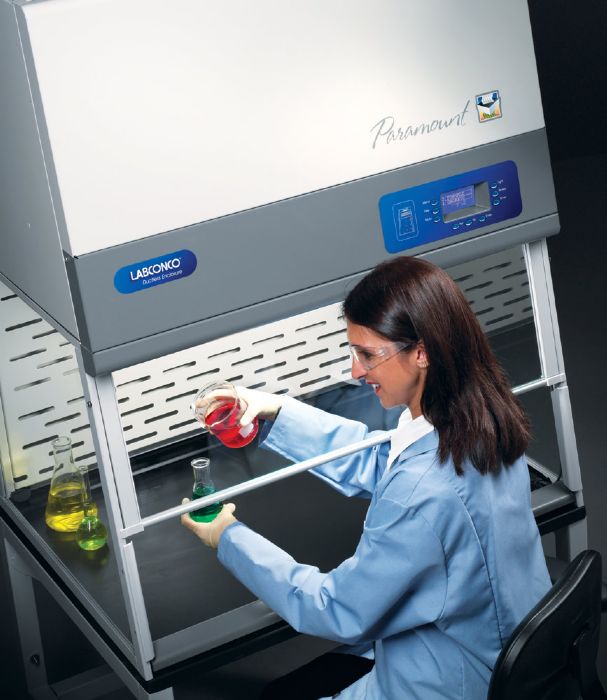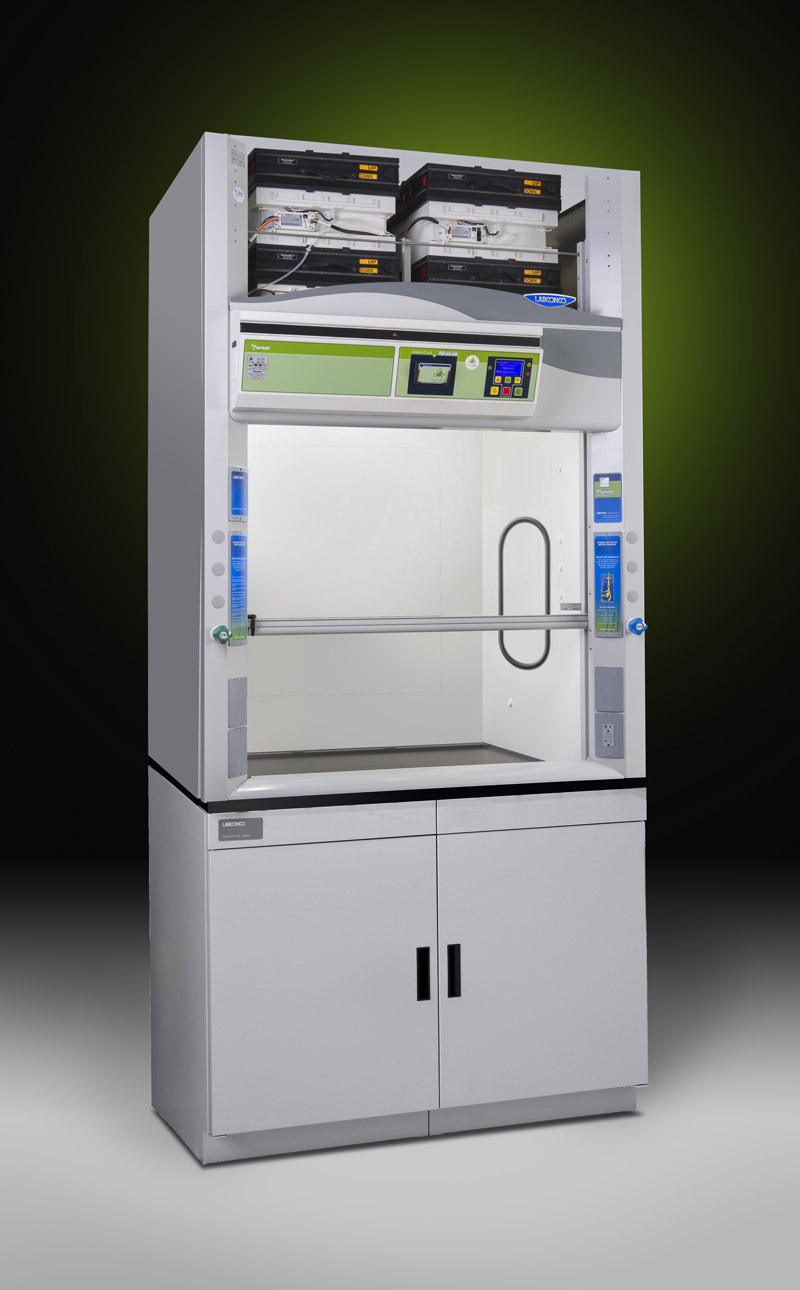4 things to consider before choosing a ductless fume hood
 Ductless fume hoods, sometimes called carbon-filtered enclosures or filtered fume hoods, are self-contained, filtered laboratory enclosures that remove hazardous fumes, vapors and particles from the laboratory. Unlike traditional fume hoods, installation costs are very low and no ductwork is required. Therefore, many people think selecting one is a slam-dunk when they first learn of them.
Ductless fume hoods, sometimes called carbon-filtered enclosures or filtered fume hoods, are self-contained, filtered laboratory enclosures that remove hazardous fumes, vapors and particles from the laboratory. Unlike traditional fume hoods, installation costs are very low and no ductwork is required. Therefore, many people think selecting one is a slam-dunk when they first learn of them.
“It takes care of the chemical fumes, it’s cheaper, and it’s an easier installation. It only makes sense, right?”
Not. So. Fast.
There are some important things to consider before making the final decision to purchase a ductless fume hood. Take these four aspects into thorough consideration to be confident that a ductless fume hood is the right choice for your laboratory and your applications:
1. Is your general application appropriate for a ductless fume hood?
Although there are different classes of ductless and filtered fume hoods, some hoods still limit applications that can be performed in them. Some ductless fume hoods should only be used light-duty or process-specific fume hoods. Other filtered fume hoods can be used for a wide range of chemicals, but keep in mind that larger chemical volumes will always shorten filter life.
This means that:
- A limited number of different chemicals should be used.
- No extreme heating should be carried out in the hood, i.e. acid digestion applications.
- Modest chemical volumes should be used, around 500 mls or less per chemical.
- Moderate chemical exposure times should be maintained.
If your application does not meet these parameters, a standard ducted fume hood is likely the best option for maximum safety and economical feasibility. If you do not know what chemicals will be used in the future, or you have a very long list of chemicals, the application would best be performed in a ducted fume hood.
At this point you should discuss your application with a Fume Hood Specialist to confirm which kind of fume hood is primarily recommended.
2. Will the chemicals involved in your application be effectively filtered with the available carbon filters?
 Typically, ductless hoods will be outfitted with chemical specific filters. Specific filter types increase chemical trapping capacity for different chemical families; however, some chemicals cannot be safely filtered or aren’t filtered effectively enough to allow ductless hoods to be a financially viable option. Filtered fume hoods can filter out acids, bases, and solvents with one filter type, however, there are still some chemicals (low molecular weight solvents) that will not be effectively filtered.
Typically, ductless hoods will be outfitted with chemical specific filters. Specific filter types increase chemical trapping capacity for different chemical families; however, some chemicals cannot be safely filtered or aren’t filtered effectively enough to allow ductless hoods to be a financially viable option. Filtered fume hoods can filter out acids, bases, and solvents with one filter type, however, there are still some chemicals (low molecular weight solvents) that will not be effectively filtered.
To filter various chemical groups, Labconco offers seven different types of carbon filters for use in our ductless fume hoods:
- HEPA (High Efficiency Particulate Air) Filter: a 99.99% efficient particulate filter for chemical powders and particulates
- Organic Carbon Filter: Activated carbon to chemically adsorb organic vapors
- Acid-Sulfur Carbon Filter: Impregnated carbon to neutralize Acids and Sulfur containing compounds
- Ammonia-Amine Carbon Filter: Impregnated carbon to neutralize ammonia/amine compounds
- Formaldehyde Carbon Filter: Impregnated carbon to neutralize formaldehyde
- Mixed Bed Carbon Filter: 60 % Impregnated carbon to neutralize acids and sulfur containing compounds (20%), Ammonia and amine compounds (20%), formaldehyde containing compounds (20%) and 40% activated carbon for organics
- Radioisotope Carbon Filter: Impregnated carbon to neutralize radioisotopes
- Neutrodine® Carbon Filters: a comprehensive filter type for use in our Echo and Airo Filtered fume hoods.
If all of the chemicals involved in your application match one of these filter types, it is a good sign that your application will be suitable for use with a ductless fume hood; however, there are some chemical exceptions with each filter type. For instance, some organics (such as methanol) are very volatile, light weight, and are not effectively adsorbed on the organic filter. Whereas some acids (like perchloric acid) present special hazards and should be used in a specialized fume hood.
The best way to determine if your chemicals are compatible with the filter types offered is to request a Chemical Assessment from our Chemical Specialists. They will review your application to help you determine if it is suitable, make appropriate equipment and filter recommendations, and provide you with any necessary precautions.
In some cases, you may be able to determine the correct filter type using our Chemical Guide for Ductless Hoods. Remember, though, the Guide is not an approved list of chemicals; you and your safety officer must ultimately determine which chemicals, quantities and filters ensure your personal safety.
3. How often will you have to replace your filters?
Although you will not have the added cost of ductwork installation and wiring associated with a standard fume hood, you will still want to consider how often you would need to replace your filters, and the maintenance costs associated with that, to calculate your estimated annual filter costs. Filter lifespans can last from a few months up to two years. You will want to find out how long the expected filter lifespan is for your application, then weigh that against the cost to install a standard fume hood. Also consider the energy cost of running a standard fume hood, which removes tempered air from the laboratory, taxing the HVAC system.
Filter life (and filter replacement times) depend on several factors:
- What chemicals are being used?
- What is the filter capacity for the chemicals being used?
- What is the evaporation rate of each chemical?
- What is the chemical volume that is being used?
- What is the duration of usage per day for each chemical?
- What is the temperature of each chemical?
Need to learn more about carbon filtration? Read these articles for further details:
- Carbon Filter Capacity: Is my filter half full, or half empty?
- Carbon Filter Capacity: Calculate This!
4. How do the pros and cons of using a ductless fume hood balance out for you?
If you have determined that a ductless fume hood is most likely suitable for your application, the last thing to do is to determine how the advantages of a ductless fume hood stand up against its disadvantages, and how both align with your company's overall goals. The following table sums up the important pros and cons, however, the final decision is up to you and your safety officer, and should be made with sufficient consideration.

When considering whether to purchase a ductless fume hood, these four important considerations will help you to make the safest, most economically sound decision for your facility.
If you have any questions regarding this information or need additional information, feel free to contact a specialist. We would love to hear from you.
| chevron_left | The CApture BT Fuming Chamber: Designed with you in mind | Articles | Smart ways to get the most out of your ScrubAir Pipette Washer/Dryer | chevron_right |






